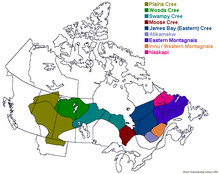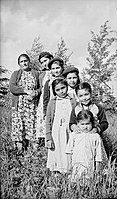
Cree
The Cree (Cree: néhinaw, néhiyaw, nihithaw, etc.; French: Cri) are a North American Indigenous people. They live primarily in Canada, where they form one of the country's largest First Nations.
For other uses, see Cree (disambiguation).
In Canada, more than 350,000 people are Cree or have Cree ancestry.[1] The major proportion of Cree in Canada live north and west of Lake Superior, in Ontario, Manitoba, Saskatchewan, Alberta, and the Northwest Territories.[3] About 27,000 live in Quebec.[4]
In the United States, Cree people historically lived from Lake Superior westward. Today, they live mostly in Montana, where they share the Rocky Boy Indian Reservation with Ojibwe (Chippewa) people.[5]
The documented westward migration over time has been strongly associated with their roles as traders and hunters in the North American fur trade.[6]
The Cree are generally divided into eight groups based on dialect and region. These divisions do not necessarily represent ethnic sub-divisions within the larger ethnic group:
Due to the many dialects of the Cree language, the people have no modern collective autonym. The Plains Cree and Attikamekw refer to themselves using modern forms of the historical nêhiraw, namely nêhiyaw and nêhirawisiw, respectively. Moose Cree, East Cree, Naskapi, and Montagnais all refer to themselves using modern dialectal forms of the historical iriniw, meaning 'man.' Moose Cree use the form ililiw, coastal East Cree and Naskapi use iyiyiw (variously spelled iiyiyiu, iiyiyuu, and eeyou), inland East Cree use iyiniw (variously spelled iinuu and eenou), and Montagnais use ilnu and innu, depending on dialect. The Cree use "Cree", "cri", "Naskapi, or "montagnais" to refer to their people only when speaking French or English.[11]
Name[edit]
The name "Cree" is derived from the Algonkian-language exonym Kirištino˙, which the Ojibwa used for tribes around Hudson Bay. The French colonists and explorers, who spelled the term Kilistinon, Kiristinon, Knisteneaux,[14][15] Cristenaux, and Cristinaux, used the term for numerous tribes which they encountered north of Lake Superior, in Manitoba, and west of there.[16] The French used these terms to refer to various groups of peoples in Canada, some of which are now better distinguished as Severn Anishinaabe (Ojibwa), who speak dialects different from the Algonquin.[17]
Depending on the community, the Cree may call themselves by the following names: the nēhiyawak, nīhithaw, nēhilaw, and nēhinaw; or ininiw, ililiw, iynu (innu), or iyyu. These names are derived from the historical autonym nēhiraw (of uncertain meaning) or from the historical autonym iriniw (meaning "person"). Cree using the latter autonym tend to be those living in the territories of Quebec and Labrador.[11]
First contact[edit]
In Manitoba, the Cree were first contacted by Europeans in 1682, at the mouth of the Nelson and Hayes rivers by a Hudson's Bay Company (HBC) party traveling about 100 miles (160 km) inland. In the south, in 1732; in what is now northwestern Ontario, Pierre Gaultier de Varennes, sieur de La Vérendrye, met with an assembled group of 200 Cree warriors near present-day Fort Frances, as well as with the Monsoni,[28] (a branch of the Ojibwe). Both groups had donned war paint in preparation to an attack on the Dakota and another group of Ojibwe.[29]
After acquiring firearms from the HBC, the Cree moved as traders into the plains, acting as middlemen with the HBC.







